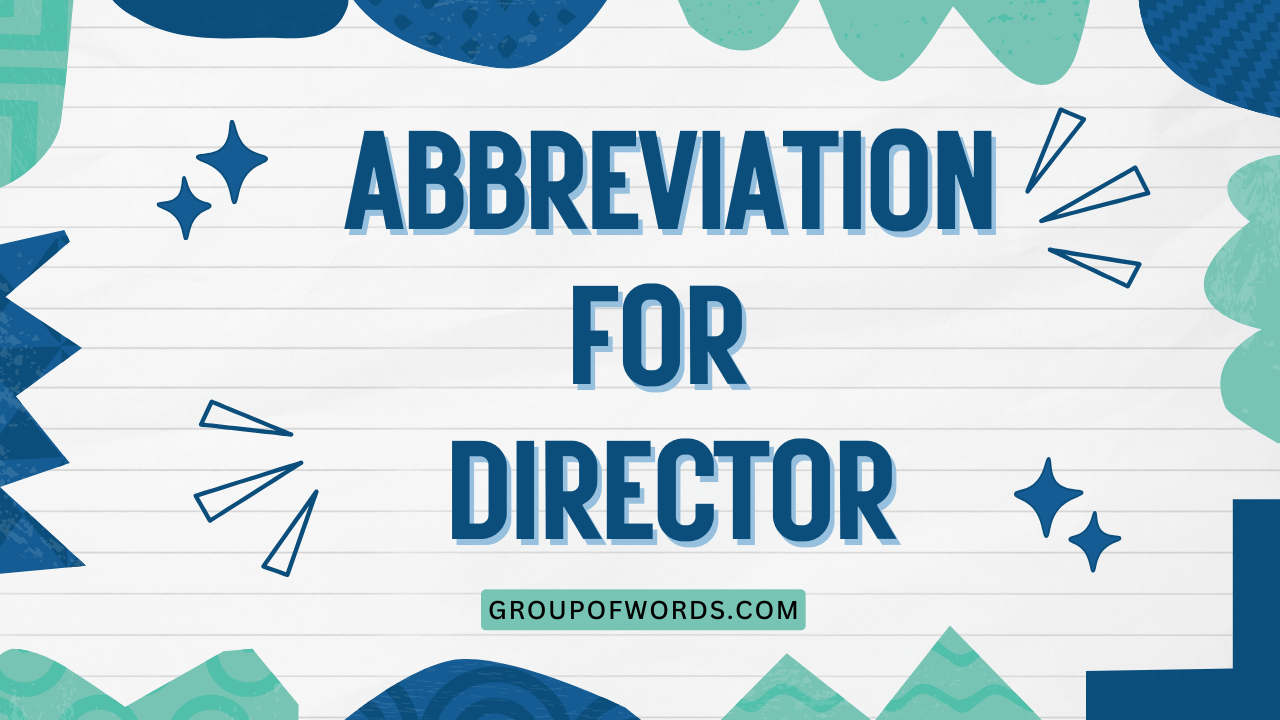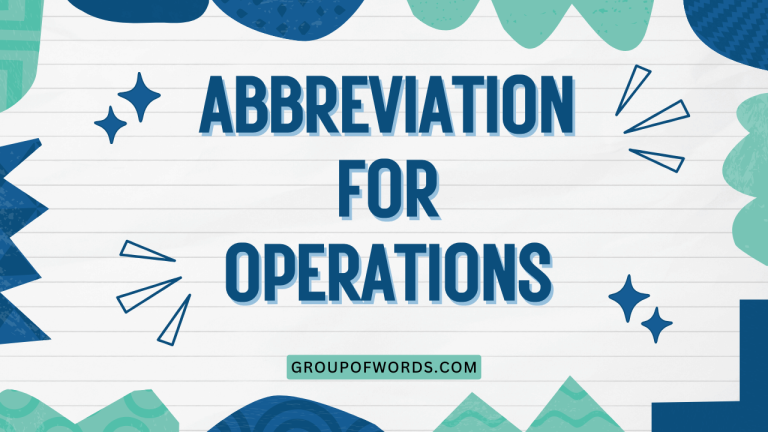Abbreviation for Director: A Comprehensive Guide
Understanding the correct abbreviations for titles, especially professional ones like “Director,” is essential for clear and concise communication in both formal and informal contexts. This article provides a detailed exploration of the abbreviation “Dir.,” its usage, and the grammatical rules that govern its application.
Whether you are a student, a professional, or simply someone looking to improve your English writing skills, this guide will equip you with the knowledge and confidence to use this abbreviation correctly.
From learning the basic definition and structure to practicing with real-world examples and exercises, this article covers all aspects of using the abbreviation “Dir.” appropriately. By the end of this guide, you will understand when and how to use “Dir.” effectively, avoiding common mistakes and enhancing your overall writing proficiency.
Table of Contents
- Definition of “Dir.”
- Structural Breakdown
- Types of Directors
- Examples of “Dir.” in Sentences
- Usage Rules
- Common Mistakes
- Practice Exercises
- Advanced Topics
- Frequently Asked Questions
- Conclusion
Definition of “Dir.”
The abbreviation “Dir.” stands for “Director.” A director is a person in charge of a specific activity or department within an organization or company. The term can also refer to a person who supervises the creative aspects of a film, play, or other production.
“Dir.” is commonly used in formal writing, such as business correspondence, reports, and official documents, to save space and maintain conciseness. It is important to note that while “Dir.” is widely accepted, it is generally more appropriate for formal contexts than casual conversation.
The function of “Dir.” is to provide a shorthand way of referring to someone holding the position of director. This abbreviation is particularly useful in lists, tables, and other situations where space is limited.
It helps maintain clarity while avoiding the repetition of the full word “Director.”
In the context of filmmaking, a director is the creative lead, responsible for overseeing all aspects of the production, from casting and script interpretation to cinematography and editing. In a business setting, a director might head a department, manage a team, or sit on the board of directors, contributing to the strategic direction of the company.
Structural Breakdown
The structure of the abbreviation “Dir.” is straightforward. It consists of the first three letters of the word “Director,” followed by a period.
The period is essential because it indicates that the word has been abbreviated. Without the period, “Dir” would simply be an incomplete word, and the reader might not understand its intended meaning.
The use of the period is a standard convention in English abbreviations. It signals to the reader that the full word has been shortened, and the period helps to differentiate the abbreviation from other words or acronyms.
This structure applies consistently across various contexts, whether it’s used in a business report, a film credit, or a formal letter.
When using “Dir.” followed by a name, it’s customary to place a space after the abbreviation. For instance, “Dir.
John Smith” is the correct format. This spacing ensures readability and professional presentation.
Types of Directors
The role of a director varies significantly depending on the industry and context. Here are some common types of directors:
Film Director
A film director is responsible for the artistic and dramatic aspects of a film. They guide the actors, oversee the cinematography, and ensure that the film aligns with their creative vision.
Board of Directors
The board of directors is a group of individuals elected to represent shareholders and oversee the management of a company. They set strategic goals, make important decisions, and ensure the company operates in the best interests of its stakeholders.
Creative Director
A creative director leads the creative team in advertising, marketing, or design. They are responsible for developing and implementing creative strategies, ensuring that the company’s brand message is consistent and effective.
Managing Director
A managing director is a senior executive responsible for the overall performance and operations of a company or a specific business unit. They oversee various departments, manage resources, and implement strategies to achieve the company’s objectives.
Project Director
A project director is responsible for planning, executing, and closing a specific project. They manage the project team, allocate resources, and ensure that the project is completed on time and within budget.
Examples of “Dir.” in Sentences
The following tables provide examples of how “Dir.” is used in various contexts. These examples illustrate the proper placement and usage of the abbreviation in sentences.
Note the consistent use of the period after “Dir.” to indicate that it is an abbreviation.
Table 1: “Dir.” in Business Contexts
This table provides examples of using “Dir.” in a business context, such as in official reports, emails, and company directories. These examples highlight the professional and concise nature of the abbreviation.
| Sentence | Context |
|---|---|
| “Please submit your reports to Dir. Emily Carter by Friday.” | Email communication |
| “Dir. Johnson will be leading the next quarterly meeting.” | Meeting announcement |
| “Contact Dir. Lee for any marketing-related inquiries.” | Company directory |
| “The board of directors includes Dir. Thompson and Dir. Davis.” | Official report |
| “Dir. Miller approved the budget for the new project.” | Project management |
| “A memo was sent out by Dir. Rodriguez regarding the new policy.” | Internal communication |
| “Dir. White’s expertise was invaluable to the success of the campaign.” | Performance review |
| “Dir. Brown is responsible for overseeing the department’s operations.” | Job description |
| “The proposal was reviewed and approved by Dir. Garcia.” | Project proposal |
| “Dir. Wilson will be presenting the annual report at the conference.” | Conference presentation |
| “Dir. Taylor emphasized the importance of teamwork during the training session.” | Training session |
| “Dir. Anderson will be available for consultations on Tuesday afternoons.” | Office hours |
| “Dir. Clark spearheaded the initiative to improve customer satisfaction.” | Company initiative |
| “Dir. Hall’s leadership was instrumental in achieving the company’s goals.” | Leadership role |
| “Dir. King presented the awards at the annual company gala.” | Company event |
| “Dir. Lewis is currently on leave and will return next month.” | Leave of absence |
| “Dir. Martin is in charge of the company’s sustainability efforts.” | Sustainability efforts |
| “Dir. Nelson’s vision has transformed the company’s approach to innovation.” | Company vision |
| “Dir. Owens is a strong advocate for employee development and training.” | Employee development |
| “Dir. Parker has implemented several key changes to improve efficiency.” | Efficiency improvements |
| “Dir. Quinn will be hosting the upcoming town hall meeting.” | Town hall meeting |
| “Dir. Reed’s strategic planning has led to significant growth for the company.” | Strategic planning |
| “Dir. Scott encourages open communication and collaboration among teams.” | Team collaboration |
| “Dir. Turner is dedicated to fostering a positive and inclusive work environment.” | Work environment |
| “Dir. Underwood’s mentorship has helped many employees advance their careers.” | Employee mentorship |
| “Dir. Vance is committed to upholding the highest standards of ethical conduct.” | Ethical conduct |
| “Dir. West’s presentations are always informative and engaging.” | Presentation skills |
| “Dir. Xavier is known for his innovative problem-solving skills.” | Problem-solving |
Table 2: “Dir.” in Film and Entertainment Contexts
This table demonstrates the use of “Dir.” in the film and entertainment industry, such as in film credits, reviews, and articles about directors.
| Sentence | Context |
|---|---|
| “The film was directed by Dir. Quentin Tarantino.” | Film review |
| “Dir. Spielberg’s latest movie is a box office hit.” | Movie news |
| “In the credits, it reads ‘Dir. of Photography: Roger Deakins.'” | Film credits |
| “Dir. Coppola’s ‘The Godfather’ is a cinematic masterpiece.” | Film analysis |
| “The documentary was directed by Dir. Ava DuVernay.” | Documentary review |
| “Dir. Scorsese is known for his gritty and realistic portrayals of urban life.” | Director profile |
| “Dir. Nolan’s films often explore complex themes of time and perception.” | Film criticism |
| “The play was directed by Dir. Julie Taymor.” | Theater review |
| “Dir. Luhrmann is known for his visually stunning and extravagant productions.” | Director interview |
| “The music video was directed by Dir. Melina Matsoukas.” | Music video review |
| “Dir. Waititi’s unique blend of humor and heart has made him a fan favorite.” | Director spotlight |
| “Dir. Gerwig’s ‘Little Women’ is a fresh and modern adaptation of the classic novel.” | Film adaptation |
| “Dir. Villeneuve’s ‘Dune’ is a visually stunning and immersive experience.” | Science fiction film |
| “Dir. Bong Joon-ho’s ‘Parasite’ made history by winning Best Picture at the Oscars.” | Award-winning film |
| “Dir. Hitchcock is often referred to as the master of suspense.” | Film history |
| “Dir. Kurosawa’s ‘Seven Samurai’ is a landmark film in the samurai genre.” | Classic film |
| “Dir. Fellini’s surreal and dreamlike style is instantly recognizable.” | Director’s style |
| “Dir. Bergman’s films often explore themes of existentialism and faith.” | Philosophical film |
| “Dir. Truffaut was a key figure in the French New Wave cinema movement.” | Film movement |
| “Dir. Almodóvar’s films are known for their vibrant colors and melodramatic storylines.” | Director’s aesthetics |
| “Dir. Lee’s films often tackle complex social and political issues.” | Social commentary |
| “Dir. Eastwood is known for his stoic and understated directing style.” | Directing style |
| “Dir. Cameron is a pioneer in the use of special effects in filmmaking.” | Special effects |
| “Dir. Fincher’s films are known for their dark and suspenseful atmosphere.” | Suspenseful atmosphere |
| “Dir. Anderson’s films are characterized by their quirky characters and whimsical settings.” | Quirky characters |
| “Dir. del Toro’s films often blend fantasy and horror elements.” | Fantasy and horror |
Table 3: “Dir.” in Academic and Research Contexts
This table showcases the use of “Dir.” in academic and research settings, such as in research papers, university directories, and grant proposals.
| Sentence | Context |
|---|---|
| “The research project is overseen by Dir. Dr. Jane Doe.” | Research paper |
| “Contact Dir. Smith at the university for more information.” | University directory |
| “Dir. Chen’s lab is conducting groundbreaking research in biotechnology.” | Research lab |
| “The grant proposal was submitted under the guidance of Dir. Brown.” | Grant proposal |
| “Dir. Garcia is a leading expert in the field of artificial intelligence.” | Academic profile |
| “The study was conducted under the supervision of Dir. Lee.” | Research study |
| “Dir. Wilson’s publications have significantly contributed to the field of economics.” | Academic publications |
| “Dir. Taylor is the head of the university’s research ethics committee.” | University committee |
| “Dir. Anderson presented the findings at the international conference.” | Conference presentation |
| “Dir. Clark’s research focuses on sustainable energy solutions.” | Research focus |
| “Dir. Hall is a visiting professor at the prestigious institution.” | Visiting professor |
| “Dir. King’s lectures are always insightful and engaging.” | University lectures |
| “Dir. Lewis is mentoring several Ph.D. students in the program.” | Ph.D. mentorship |
| “Dir. Martin is actively involved in community outreach programs.” | Community outreach |
| “Dir. Nelson’s expertise is sought after by various government agencies.” | Government consultation |
| “Dir. Owens has received numerous awards for her contributions to science.” | Awards and recognition |
| “Dir. Parker is collaborating with researchers from around the world.” | International collaboration |
| “Dir. Quinn is leading the effort to secure funding for the new research center.” | Funding acquisition |
| “Dir. Reed is committed to promoting diversity in the field of STEM.” | Diversity in STEM |
| “Dir. Scott is known for his innovative teaching methods.” | Teaching methods |
Usage Rules
There are several key rules to follow when using the abbreviation “Dir.”:
- Always use a period after “Dir.” The period indicates that the word is abbreviated.
- Use a space after “Dir.” when followed by a name. For example, “Dir. John Smith.”
- Use “Dir.” in formal contexts. It is generally more appropriate for business, academic, and professional writing.
- Avoid using “Dir.” in casual conversation or informal writing. In these contexts, it is better to use the full word “Director.”
- Be consistent in your usage. If you choose to abbreviate “Director” as “Dir.” throughout a document, do so consistently.
While “Dir.” is widely accepted, it’s important to consider your audience and the overall tone of your writing. In some cases, using the full word “Director” may be preferable, especially if you want to avoid any potential ambiguity or maintain a more formal tone.
Common Mistakes
Here are some common mistakes to avoid when using the abbreviation “Dir.”:
- Forgetting the period: Writing “Dir” instead of “Dir.” is a common error. Always include the period to indicate that it is an abbreviation.
- Using “Dir.” in informal contexts: Using “Dir.” in casual conversations or informal emails can sound overly formal.
- Inconsistent usage: Switching between “Dir.” and “Director” within the same document can be confusing. Choose one and stick with it.
- Misunderstanding the meaning: Confusing “Director” with other similar-sounding words or titles.
Here’s a table illustrating common mistakes and their corrections:
| Incorrect | Correct | Explanation |
|---|---|---|
| “Please contact Dir Smith for assistance.” | “Please contact Dir. Smith for assistance.” | Missing period after “Dir.” |
| “The film was made by Director Spielberg.” | “The film was made by Dir. Spielberg.” | Inconsistent usage within a formal document |
| “Dir is responsible for the team.” | “Dir. is responsible for the team.” | Missing period after “Dir.” |
| “I spoke to Dir about the issue.” | “I spoke to the Director about the issue.” | Inappropriate use in casual conversation |
Practice Exercises
Test your understanding of the abbreviation “Dir.” with these practice exercises. Choose the correct sentence from the options provided.
Exercise 1
Choose the correct sentence:
| Question | Options | Answer |
|---|---|---|
| Which is the correct way to write the abbreviation for Director followed by a name? |
a) Dir Smith b) Dir. Smith c) Dir.Smith |
b) Dir. Smith |
| Which sentence is correctly using the abbreviation? |
a) Speak to Dir about the project. b) Speak to Dir. about the project. c) Speak to Director about the project. |
c) Speak to Director about the project. |
| Which of these is the proper abbreviation for Director in a formal document? |
a) Director. b) Dir c) Dir. |
c) Dir. |
| Which option correctly uses the abbreviation in a sentence? |
a) The report was submitted to Dir. Jones. b) The report was submitted to Dir Jones. c) The report was submitted to Director Jones. |
a) The report was submitted to Dir. Jones. |
| Choose the correct usage in an email: |
a) Ask Dir.Lee for approval. b) Ask DirLee for approval. c) Ask Director Lee for approval. |
a) Ask Dir.Lee for approval. |
| Which sentence is appropriate for a formal report? |
a) Dir Smith approved the budget. b) Dir. Smith approved the budget. c) Director Smith approved the budget. |
b) Dir. Smith approved the budget. |
| Select the correct sentence for a meeting announcement: |
a) Dir. Johnson will lead the meeting. b) Dir Johnson will lead the meeting. c) Director Johnson will lead the meeting. |
a) Dir. Johnson will lead the meeting. |
| Which option is best for a company directory? |
a) Contact Dir. Adams for details. b) Contact Dir Adams for details. c) Contact Director Adams for details. |
a) Contact Dir. Adams for details. |
| Pick the correct sentence for a film credit: |
a) Dir. of Photography: John Doe b) Dir of Photography: John Doe c) Director of Photography: John Doe |
a) Dir. of Photography: John Doe |
| What is the correct way to refer to the head of a research project in a paper? |
a) Dir. Dr. Smith b) Dir Dr. Smith c) Director Dr. Smith |
a) Dir. Dr. Smith |
Advanced Topics
For advanced learners, it’s important to understand the nuances of using abbreviations in different contexts. While “Dir.” is a common abbreviation, there are situations where it may be more appropriate to use the full word “Director.” This is especially true in formal writing where clarity and precision are paramount.
Additionally, understanding the different types of directors and their specific roles can help you use the abbreviation more effectively. For example, knowing whether someone is a film director, a board member, or a department head can provide valuable context when using “Dir.” in your writing.
Furthermore, consider the cultural and regional variations in abbreviation usage. While “Dir.” is widely accepted in English-speaking countries, other languages may have different conventions for abbreviating titles and professional designations.
Always be mindful of your audience and adapt your writing accordingly.
Frequently Asked Questions
Here are some frequently asked questions about the abbreviation “Dir.”:
- Is it always necessary to use a period after “Dir.”?
Yes, the period is essential because it indicates that the word has been abbreviated. Without the period, it is not considered a correct abbreviation. - Can I use “Dir.” in casual conversation?
While technically correct, using “Dir.” in casual conversation may sound overly formal. It’s generally better to use the full word “Director” in informal settings. - Is “Dir.” the only acceptable abbreviation for “Director”?
Yes, “Dir.” is the most widely recognized and accepted abbreviation for “Director.” Other variations are not commonly used. - Should I capitalize “Dir.”?
Yes, “Dir.” should be capitalized when it precedes a proper name, just like the full word Director. For example, “Dir. John Smith.” - What if I’m referring to multiple directors?
When referring to multiple directors, use “Dirs.” as the plural abbreviation. For example, “The Dirs. of the company met to discuss the new strategy.” - How do I use “Dir.” with other titles like “Dr.” or “Prof.”?
When using “Dir.” with other titles, follow the standard order of titles. For example, “Dir. Dr. Jane Doe” or “Dir. Prof. Michael Brown.” - Is it okay to use “Dir.” in academic papers?
Yes, “Dir.” is acceptable in academic papers, especially in contexts where space is limited, such as tables or lists. However, be consistent with your usage and follow the guidelines of the specific academic journal or publication. - Are there any situations where I should avoid using “Dir.”?
In highly formal or legal documents, it may be preferable to use the full word “Director” to avoid any potential ambiguity. Always consider the context and audience when deciding whether to use the abbreviation.
Conclusion
Mastering the use of the abbreviation “Dir.” is crucial for effective communication in various professional and academic contexts. By understanding its definition, structure, and usage rules, you can confidently incorporate this abbreviation into your writing, enhancing clarity and conciseness.
Remember to always use a period after “Dir.,” maintain consistency in your usage, and consider the context and audience when deciding whether to abbreviate or use the full word “Director.” With practice and attention to detail, you can avoid common mistakes and elevate your writing skills.
Continue to explore and refine your understanding of English grammar, and you’ll be well-equipped to communicate effectively in any situation. Keep practicing with different examples and exercises to solidify your knowledge and build your confidence.






